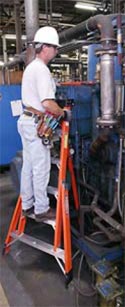
Handy Links
SLAC News Center
SLAC Today
- Subscribe
- Archives: Feb 2006-May 20, 2011
- Archives: May 23, 2011 and later
- Submit Feedback or Story Ideas
- About SLAC Today
SLAC News
Lab News
- Interactions
- Lightsources.org
- ILC NewsLine
- Int'l Science Grid This Week
- Fermilab Today
- Berkeley Lab News
- @brookhaven TODAY
- DOE Pulse
- CERN Courier
- DESY inForm
- US / LHC
SLAC Links
- Emergency
- Safety
- Policy Repository
- Site Entry Form

- Site Maps
- M & O Review
- Computing Status & Calendar
- SLAC Colloquium
- SLACspeak
- SLACspace
- SLAC Logo
- Café Menu
- Flea Market
- Web E-mail
- Marguerite Shuttle
- Discount Commuter Passes
-
Award Reporting Form
- SPIRES
- SciDoc
- Activity Groups
- Library
Stanford
Around the Bay
Ladder Safety

Just as you check any other tool or instrument before starting work, so should you check your ladder. It's easy to take ladders for granted at SLAC; they are everywhere, from the office to the back of a work truck. Used incorrectly, a ladder can become your enemy. More than 500,000 people across the U.S. are injured every year using ladders incorrectly.
Use these tips to keep yourself safe while using a ladder:
• Use the correct ladder for the work: single, extension or step.
• Choose the correct height and duty rating.
• Never use a ladder if it is damaged, broken or bent.
• Read the manufacturer's recommendations for the ladder.
• In setting up a ladder, make sure its feet are on firm, even ground.
• Keep your body between the rails: use the "belt buckle" rule.
• Never stand on the ladder top (cap) or the rung just below it.
• Do not stand at or above the third rung of a straight or extension ladder.
• Do not "jog" the ladder over; get off the ladder and move it to the new work area.
• Take your time when working with ladders; don’t be in a rush to finish a job.
• If you feel dizzy, tired or are taking medication, stay off of the ladder.

• Focus on the job in front of you: climbing the ladder safely!
• Use a tool belt, bucket or other means to bring your tools up to the work area; keep your hands free to climb the ladder.
• When moving the ladder carry it correctly: rails parallel to the ground or floor.
Remember, if you have to use a ladder to perform your work at SLAC, you must have completed Course 293 (online or in the classroom) before you can use the ladder. If you have questions, need ladder training or are just curious please read ES&H Chapter 15 and review ES&H online Course 293. This information has been captured in a tri-fold brochure.
óJim Healy
SLAC Today, December 10, 2008